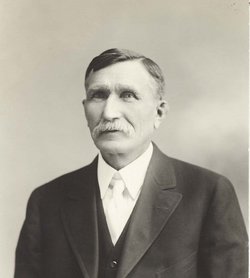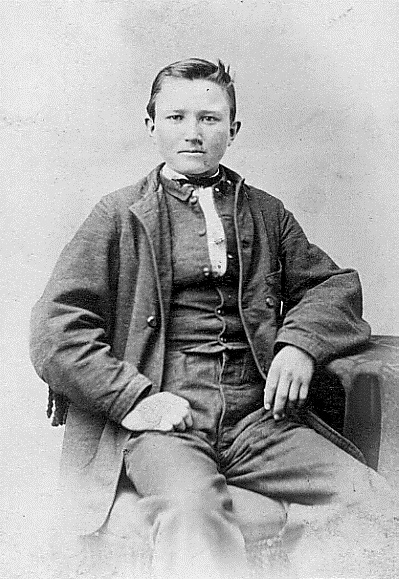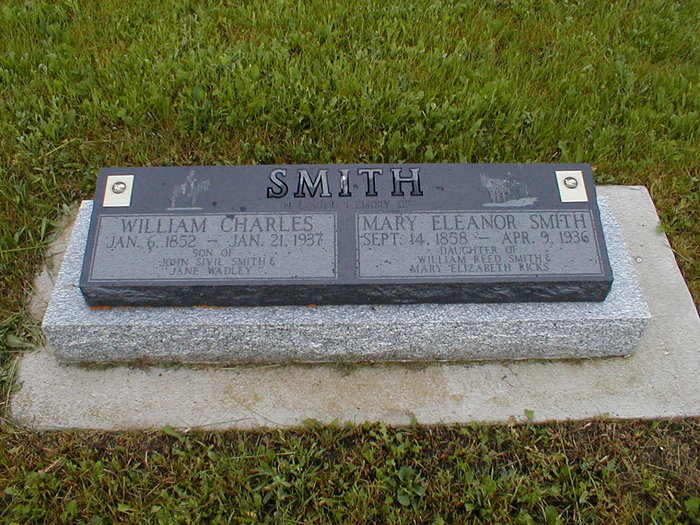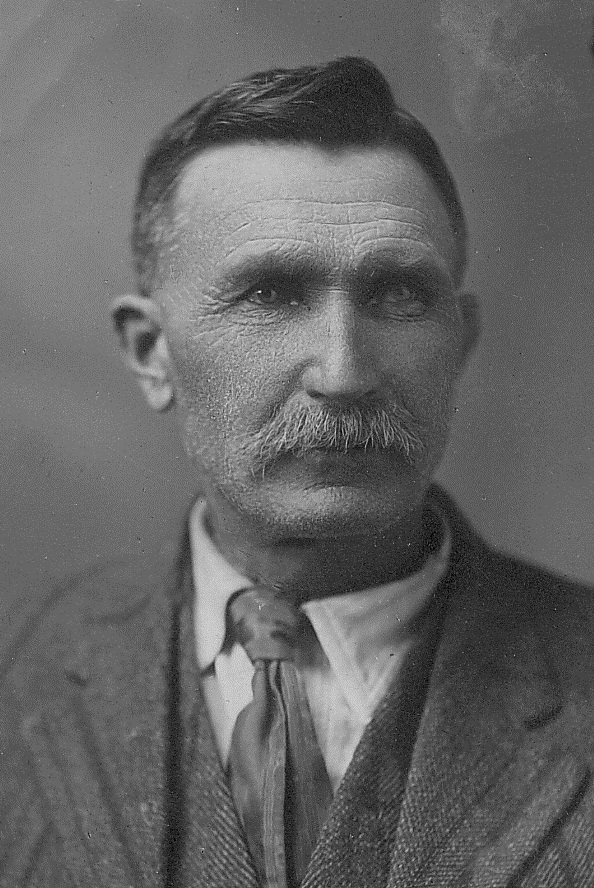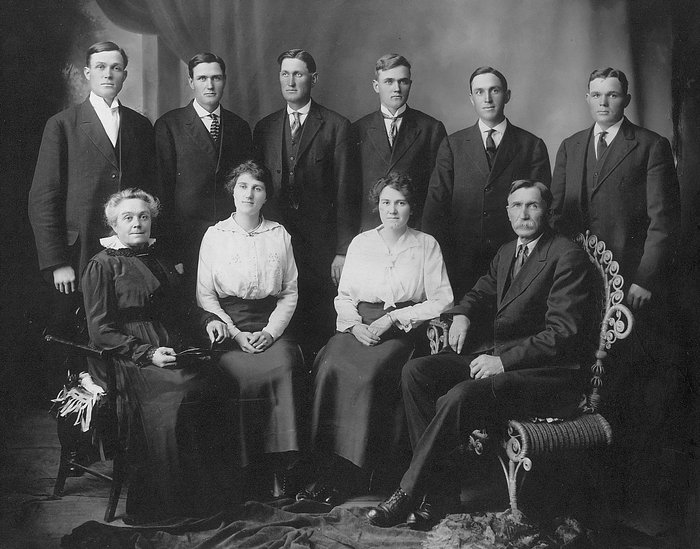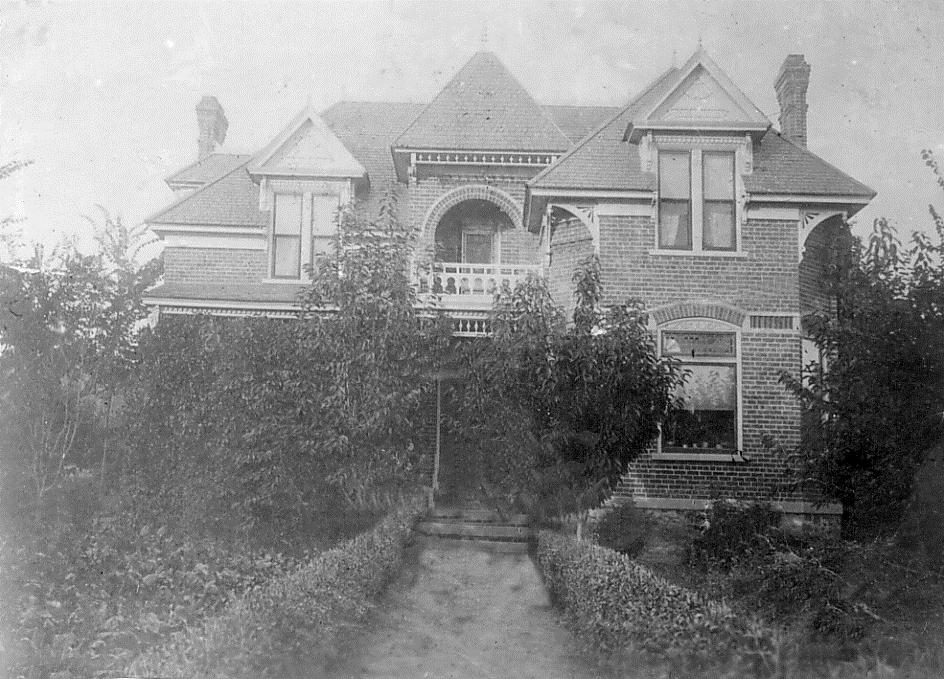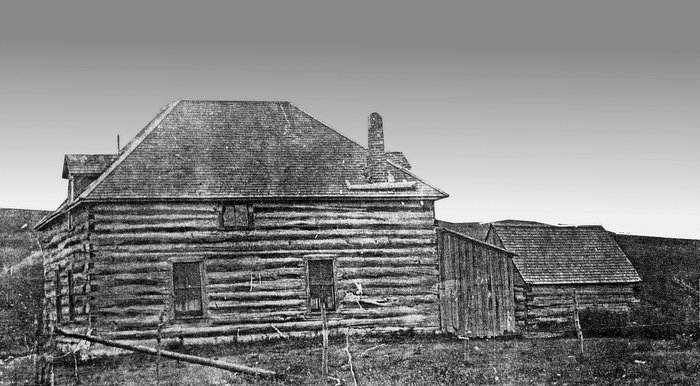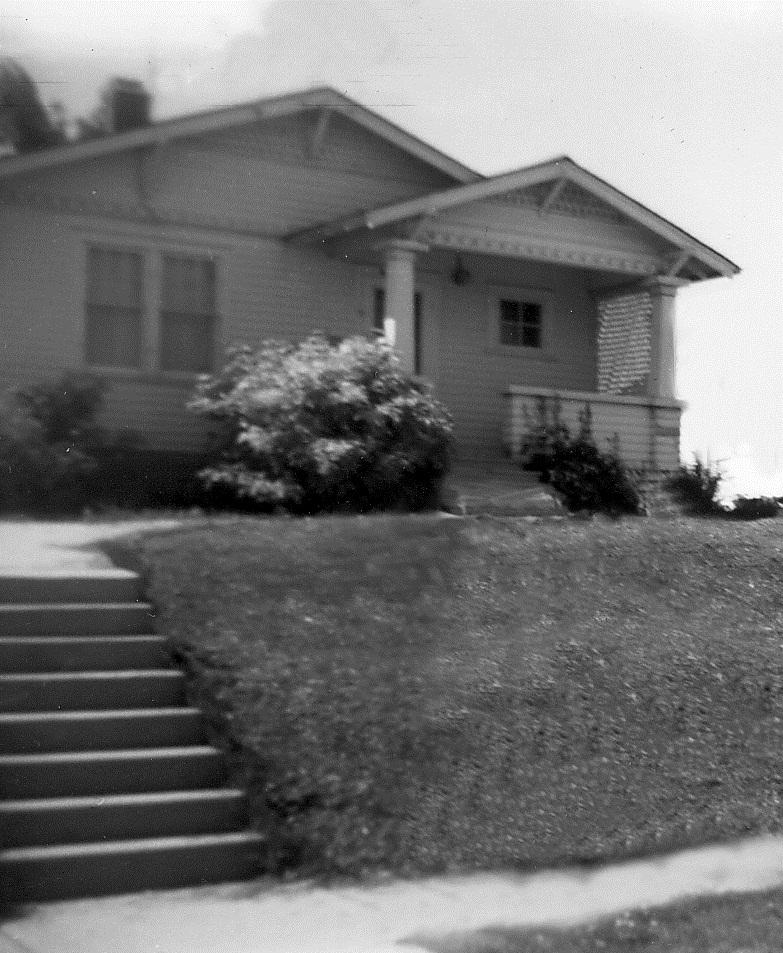A.K.A. "Dogie Smith" or "Rawhide Bill"
Compiled by great grand-daughters Joy Smith Steed and Valerie Smith Olsen
William Charles Smith, referred to often as Dogie Smith or Rawhide Bill, was once described by E.J. Wood as "a man whose life on the range and in the great open spaces had so succeeded in tempering his life that he had become one of the most loyal men in the church, a man of great respect and reverence, one who delighted to spend years of his life in service uncomplainingly." He had a cheerful disposition, a ready wit and an ability to tell stories which made him most agreeable company.
Viola Wynder of Hill Spring told this story of him: One day I was getting dinner in the granary when a shadow darkened the door. I stepped to the door and a man's voice said, "Do you know who I am?" I said, "No". "Well I'm Dogie Smith, the father of Frank and Will and Seymour and Archie and so on ." I had heard of him, how he was nicknamed "Dogie" because he had driven cattle or dogies, so I said to him, "The men will soon be in for dinner. Put your horse up and have dinner with us." He was a wonderful character, as hard as the times he lived in. We had dinner and he spent the afternoon telling me his life story. That night at eleven o'clock he was still talking to us, so I made him a bed. The next morning about eleven o'clock he went home with the pepper he had come to borrow to treat a sick horse. He came back several days later and said that the horse was "deader than hell" when he reached home. He was lonesome and so was I, so I was happy that he came often to tell me of the wonderful experiences he had on the frontier.
William Charles was especially fond of and good to children. He was blessed with a good memory and a most observing alertness. This was of use to him throughout his life. He had a great love for horses and cattle and everything associated with this kind of life. Indeed, Dogie Smith came into the world in conditions not uncommon to range or prairie life. The night he was born,6 January 1852 in Draper, Utah, it began to snow. The storm dumped, on the level, four feet of the white stuff. Sheep and cows were buried under this blanket for three days. The home in which he was born, and lived for the next four years of his life, consisted of two rooms - a log room and an adobe one having a dirt floor and a thatched roof. The beds were built of log poles. The cooking was done over a fireplace and the baking was done in an adobe oven.
This kind of life was very much different for William Charles' mother who was at one time a cook for Queen Victoria. Jane Wadley was reared in a home of culture and refinement in Gloucester, England and was a lady in every respect. She was given the best education obtainable. In 1838 Jane Wadley married John Sivel Smith, a stately six foot tall honest and successful businessman. Jane taught her husband to read and write but even without tutoring he was a mathematical wizard.
Jane Wadley Smith had a great knowledge and love of the Bible. When her husband John Sivel returned home from work one evening he explained to her that he had just heard "the real gospel." She too was deeply interested. John Sivel had heard from an open window of a building, a man, - that of Wilford Woodruff he later learned, preaching the gospel. He was impressed. Later John and Jane went again to hear Brother Woodruff and were baptized in 1841. Thus it became their desire to come to "Zion". After spending two months on the Atlantic Ocean on the ship "Harmony" the couple and their infant daughter landed in Quebec, and from there traveled to Nauvoo. Both were present when the Prophet Joseph Smith delivered his last address to the Nauvoo Legion. They were also in attendance at the meeting held in 1844 when the mantle of the Prophet Joseph fell upon Brigham Young. Brigham Young was not present at the meeting when it started, but had been called back from a mission when Joseph Smith was martyred. Brigham Young came up from the boat and took his place on the stand. Grandmother Smith had leaned over her baby and just then Brigham Young began to speak. She raised up suddenly because she heard what she believed was the Prophet's voice, although she knew he was dead. This thoroughly convinced them that Brigham Young was the chosen man of God.
John Sivel and Jane Smith suffered many hardships and poverty while in America. Their lives were threatened many times by mobs. Their first home in America, located just outside Nauvoo was of logs with a blanket hung in the opening for a door. One night a member of a mob raised the blanket and shot into the room. It grazed John Sivel's head and lodged in the wall just over his head. The next morning, he told members of the mob that it was a close shot, but would have to be closer than that to get him. He told the mob to be patient and he would leave Nauvoo as quickly as possible.
Three children were born in Nauvoo but all died.
John Sivel was a wheelwright and carpenter and after being forced to leave Nauvoo because of persecution he worked in Council Bluff repairing and building wagons to be used in crossing the plains. The little family left for the Salt Lake Valley in May 1850 with the William Snow Company. They were well equipped for the journey. A team of mares on a light wagon was provided for his wife and children. A heavy wagon drawn by a yoke of oxen and a yoke of cows was loaded with supplies, furniture and needs of a new country. After arriving in Salt Lake City they moved to Draper. Here a son, the first male to be born in Draper, was born to Jane and John Sivel Smith. They named him William Charles. Other children born to John Sivel and Mary Wadley Smith included Elizabeth, Joseph, Harriet, George, Ellen and Eliza.
William Charles as a boy made many friends because of his friendly jovial personality. When he started school his mother would fix sorghum and molasses sandwiches, the only food available. It is told that he and his friends would beat each other over the head with their lunches on the way to school. He had little schooling only reaching the fourth grade.
When ten years old Will, as he was called was sent by his father out to the Hooper-Knowlton ranch in Skull Valley -- west of the Salt Lake. John Quincy Knowlton had married William Charles sister, Ellen.
William's Uncle John Quincy had been given charge of the Smith stock. Will, being a lover of horses and cattle was great help. Because of his good memory and quick observing powers, he never forgot an animal, its coloring, brand or where seen. This characteristic made him most valuable not only to his own interest, but to all the ranchers in the vicinity wherever he lived.
In 1847 Will received a call to go down to the Big Muddy in Arizona. He did not remain there long but returned to care for his fathers stock. He was called to assist in building the Salt Lake Temple. With ox teams he hauled stone from Cottonwood Canyon.
Good fortune met with Will at the age of 30 when he met Mary Eleanor Smith, a comely young school teacher boarding with his parents. They married 12 January 1882 in the Endowment House in Salt Lake City. Mary E. was much like her own mother in that she was well educated, a student of the Bible, and an excellent homemaker. Mary was a triplet born on 14 September 1858 in Centerville, Utah to parents William Reed and Mary Elizabeth Ricks Smith. The other two babies were dead at birth. Weighing two and half pounds at birth, Mary Eleanor was carried on a pillow and fed from the tip of spoon for sometime. Even in her early school education Mary Eleanor showed a marked and unusual ability in spelling, reading and pronunciation. She also took a special course in penmanship for which she received top honors. At the age of 16 she taught school in Centerville. Then to further qualify herself as a teacher she attended the University of Desert in Salt Lake City during the school year of 1878 and 1879 after which she was assigned to teach in West Kaysville School. It was there at age 24 she met Will, married and resided for a year or more. The first child born to William Charles and Mary Eleanor was named Seymour Bicknell Smith. A second son was named William Charles Jr.
In the spring of 1885 the family moved to a ranch on the Portneuf River, four miles southwest of Chesterfield, Idaho. They built a four room log house.
While in Chesterfield, Idaho five children were born to them; John Sivil on 21 October 1985; Frank Reed on 2 June 1987; Mary on 18 November 1988; Jane on 9 November 1890 and Thomas Archie on 1 February 1894. The school facilities were inadequate, so William and Mary Eleanor decided to move their family to Kaysville in the early spring of 1895. They built a modern, two-story brick house south of his father's home. [Presently this home of William Charles & Mary Eleanor Smith is located at 388 North Angel Street, Kaysville, Utah]. William Charles with hired help, cared for the ranch and stock during the winter. Mary and the children spent the summers on the ranch while the crops were harvested. While living in Kaysville, two sons were born; James Ricks on 11 February 1897 and Harold Vivian in 26 August 1900.
Will Jr. told about when they lived in Chesterfield, Idaho where their cattle ranch was.
"The Church Authorities used to come out for their tithing. They would always come and stay overnight. William Charles Sr. would ask the General Authorities how many they needed. They would tell him and that was the number the boys were sent out to round up and bring in. They were always told to bring in the best of the herd. They would put the cattle in the corral and slaughter them that afternoon, hanging them to cure in the cool night. The next morning they were taken down and put in the back of the buckboard and covered with tarps. The General Authorities or the members of the Quorum of Twelve or whoever was there would take them back down to the Bishop's Storehouse for service. This he said, was one way that he always remembered his father - that at no time did he send the scrubs. He always sent the choicest of his herd."
William Charles was successful in Idaho. He built up a splendid ranch and accumulated a big herd of cattle and a sizable band of horses. However, the ranchers of Chesterfield were informed that the Indian land leases would expire in the summer of 1900. Grandfather, hearing that Southern Alberta, Canada was a stockman's paradise, went to investigate. He found the country to be as purported, bunch grass such as he had never before seen. His stirrups drug in the grass as he rode through the hills. A letter was sent home to Mary Eleanor, his wife, containing only one long blade of grass. Two sections of land were purchased in Mountain View. He returned to Idaho and sold out his ranch and started with a neighbor, Mr. Eldredge, driving 800 head of cattle and 50 head of horses on a long trek to Canada. In March 1900, William Jr., age 16 and John, age 14 accompanied the hired men on the journey. They didn't move very fast because they wanted to graze the cattle to keep them in good condition. Some of the hired men were unscrupulous and caused the two lads to endure many hardships. William Jr. told the story of when the cattle were without water for three days. When they came within five or six miles of Missouri River, the men couldn't hold the cattle. There was pile up at the river and some cattle drowned. It took three months to reach the Canadian border.
The cattle were quarantined for three weeks at Coutts. During this time Dogie Smith was fencing his land in Mountain View, buying hay, and supervising the building of a two story forty by forty foot log home and settling business in Kaysville.
Mary Porter tells of the journey to Mountain View.
"4 February 1901, father, mother and six of we youngest children left Idaho for our new home. When we arrived at Stirling, Alberta we had to lay over for the night. Harold was taken sick with pneumonia and Ricks had bronchitis the next morning. Father took Frank, Jane and Archie on the train, leaving me to assist mother in caring for the two sick children. Three weeks later, father met us in Cardston and took us to our new home - a log house forty by forty."
In spite of the severe weather and many hardships, Mary Eleanor experienced, she never regretted having made the move for she felt there was no better place in which to rear a family.
The first winter in this country was a hard, cold one. The cattle were thin and father had not sufficient hay for them. Many of them died. Father was a good provider, kind and generous with not only his family but with his neighbors also.
In 1903, when a fierce rainstorm turned the little creeks into raging rivers, one of their neighbors lost his eighteen year old son and all of his cows that the boy was trying to save from the flood waters. Father sent six of his choice milk cows, with his love and sympathy, to the bereaved family that they might have a means of livelihood.
William Charles Jr. remembers as a boy visiting with his grandpa William Charles Smith Sr. and grandma, Mary Eleanor. At the time she was the Relief Society President. They would kill two steers. One would be cut up for grandma to take around to the poor people, and grandpa would stand at the meat block and ask how much she wanted for this family and how much she wanted for that one. Grandma would stand there with a notebook and tell him what she wanted and that was the way it was.
Dogie Smith was an example of generosity to his friends and family but was "generous to a fault". He was often taken advantage of by men masquerading as friends. Two such men got him to join them in a business venture, almost ruining him financially.
As a mother, wife and neighbor Mary Eleanor was held in high esteem. She was a tireless worker in the church organizations, especially in Stake and ward Relief Society. It was during this time that members of the church had a great need for parental guidance. Mary Eleanor was called to make a outline of a course of study to meet this need. Thus the first Parent's class in the church came into being. She also prepared a course of study to be used in the Stake Relief Society. No road was too long, too muddy or too drifted with snow to keep her from performing and fulfilling her appointments. She was always visiting the needy and the sick. Her children regarded her as an excellent cook, entertaining a lot of company and remember her strict observance of the Sabbath. Often she read the Bible to them and made them study their school lessons. It was important to her that all her children receive a good education. John Smith, a son, said "no sacrifice was too great for her children. To her I owe more than any other... Mother wasn't demonstrative, didn't use endearing terms, didn't coddle or praise us before company, but she loved us deeply and manifested an expression of approval when we did well or pleased her. She was usually the last of the household to retire and the first to arise in the morning. She was exceptionally thrifty, economical and industrious. She was seemingly a tireless worker to the last. She did anything that needed doing outside as well - milking cows, tending the garden."
Each of William Charles & Mary Eleanor's children honored and revered their parents and tried to live up to the teachings given them in their youth.
Mary Smith Steed Porter tells of William Charles and Mary Eleanor's later life.
Mother and father built a modern home on the ranch on 1916. They were called on a six month mission to California in the fall of 1917. Two years later father was called to Northern California on another six month mission.
When the Alberta Temple was completed in 1923, they were called as temple workers. They rented a house and moved into Cardston. After working in the temple for nine years William Charles health failed. Mary Eleanor cared for him for over a year when she became ill with a heart attack. She was taken to Jane's home in Mountain View. Will Jr. took father to his home in Hill Spring.
Mary Eleanor went to Centerville, Utah in October thinking the change would do her good. She passed away there 9 April 1936 at the home of her daughter Mary. After her death William Charles grew steadily weaker. He passed away at their home in Cardston on 21 January 1937. A heavy snow had fallen, blocking all roads. It was necessary for Seymour to have a band of horses drive from the ranch at Mountain View to Cardston to pack the road. The horses were then driven back in front of the sleigh drawn by four horses carrying father body to the cemetery. This was a fitting end for father as horses played such an important part throughout his entire life time. He was laid to rest 24 January 1937 by the side of his beloved wife in the Mountain View Cemetery.
This ended the active live of a frontiersman - leaving a host of friends, seven of his nine children and thirty seven grandchildren.
He was an expert horseman and an adapt cattleman. He was over six feet tall, straight and agile until his illness two years before his passing. He had twinkling blue eyes and dark hair that never grew grey with the years.
The name of Mary Eleanor and William Charles Smith has been handed down to their posterity in honorable remembrance.
A.K.A. "Dogie Smith" or "Rawhide Bill"
Compiled by great grand-daughters Joy Smith Steed and Valerie Smith Olsen
William Charles Smith, referred to often as Dogie Smith or Rawhide Bill, was once described by E.J. Wood as "a man whose life on the range and in the great open spaces had so succeeded in tempering his life that he had become one of the most loyal men in the church, a man of great respect and reverence, one who delighted to spend years of his life in service uncomplainingly." He had a cheerful disposition, a ready wit and an ability to tell stories which made him most agreeable company.
Viola Wynder of Hill Spring told this story of him: One day I was getting dinner in the granary when a shadow darkened the door. I stepped to the door and a man's voice said, "Do you know who I am?" I said, "No". "Well I'm Dogie Smith, the father of Frank and Will and Seymour and Archie and so on ." I had heard of him, how he was nicknamed "Dogie" because he had driven cattle or dogies, so I said to him, "The men will soon be in for dinner. Put your horse up and have dinner with us." He was a wonderful character, as hard as the times he lived in. We had dinner and he spent the afternoon telling me his life story. That night at eleven o'clock he was still talking to us, so I made him a bed. The next morning about eleven o'clock he went home with the pepper he had come to borrow to treat a sick horse. He came back several days later and said that the horse was "deader than hell" when he reached home. He was lonesome and so was I, so I was happy that he came often to tell me of the wonderful experiences he had on the frontier.
William Charles was especially fond of and good to children. He was blessed with a good memory and a most observing alertness. This was of use to him throughout his life. He had a great love for horses and cattle and everything associated with this kind of life. Indeed, Dogie Smith came into the world in conditions not uncommon to range or prairie life. The night he was born,6 January 1852 in Draper, Utah, it began to snow. The storm dumped, on the level, four feet of the white stuff. Sheep and cows were buried under this blanket for three days. The home in which he was born, and lived for the next four years of his life, consisted of two rooms - a log room and an adobe one having a dirt floor and a thatched roof. The beds were built of log poles. The cooking was done over a fireplace and the baking was done in an adobe oven.
This kind of life was very much different for William Charles' mother who was at one time a cook for Queen Victoria. Jane Wadley was reared in a home of culture and refinement in Gloucester, England and was a lady in every respect. She was given the best education obtainable. In 1838 Jane Wadley married John Sivel Smith, a stately six foot tall honest and successful businessman. Jane taught her husband to read and write but even without tutoring he was a mathematical wizard.
Jane Wadley Smith had a great knowledge and love of the Bible. When her husband John Sivel returned home from work one evening he explained to her that he had just heard "the real gospel." She too was deeply interested. John Sivel had heard from an open window of a building, a man, - that of Wilford Woodruff he later learned, preaching the gospel. He was impressed. Later John and Jane went again to hear Brother Woodruff and were baptized in 1841. Thus it became their desire to come to "Zion". After spending two months on the Atlantic Ocean on the ship "Harmony" the couple and their infant daughter landed in Quebec, and from there traveled to Nauvoo. Both were present when the Prophet Joseph Smith delivered his last address to the Nauvoo Legion. They were also in attendance at the meeting held in 1844 when the mantle of the Prophet Joseph fell upon Brigham Young. Brigham Young was not present at the meeting when it started, but had been called back from a mission when Joseph Smith was martyred. Brigham Young came up from the boat and took his place on the stand. Grandmother Smith had leaned over her baby and just then Brigham Young began to speak. She raised up suddenly because she heard what she believed was the Prophet's voice, although she knew he was dead. This thoroughly convinced them that Brigham Young was the chosen man of God.
John Sivel and Jane Smith suffered many hardships and poverty while in America. Their lives were threatened many times by mobs. Their first home in America, located just outside Nauvoo was of logs with a blanket hung in the opening for a door. One night a member of a mob raised the blanket and shot into the room. It grazed John Sivel's head and lodged in the wall just over his head. The next morning, he told members of the mob that it was a close shot, but would have to be closer than that to get him. He told the mob to be patient and he would leave Nauvoo as quickly as possible.
Three children were born in Nauvoo but all died.
John Sivel was a wheelwright and carpenter and after being forced to leave Nauvoo because of persecution he worked in Council Bluff repairing and building wagons to be used in crossing the plains. The little family left for the Salt Lake Valley in May 1850 with the William Snow Company. They were well equipped for the journey. A team of mares on a light wagon was provided for his wife and children. A heavy wagon drawn by a yoke of oxen and a yoke of cows was loaded with supplies, furniture and needs of a new country. After arriving in Salt Lake City they moved to Draper. Here a son, the first male to be born in Draper, was born to Jane and John Sivel Smith. They named him William Charles. Other children born to John Sivel and Mary Wadley Smith included Elizabeth, Joseph, Harriet, George, Ellen and Eliza.
William Charles as a boy made many friends because of his friendly jovial personality. When he started school his mother would fix sorghum and molasses sandwiches, the only food available. It is told that he and his friends would beat each other over the head with their lunches on the way to school. He had little schooling only reaching the fourth grade.
When ten years old Will, as he was called was sent by his father out to the Hooper-Knowlton ranch in Skull Valley -- west of the Salt Lake. John Quincy Knowlton had married William Charles sister, Ellen.
William's Uncle John Quincy had been given charge of the Smith stock. Will, being a lover of horses and cattle was great help. Because of his good memory and quick observing powers, he never forgot an animal, its coloring, brand or where seen. This characteristic made him most valuable not only to his own interest, but to all the ranchers in the vicinity wherever he lived.
In 1847 Will received a call to go down to the Big Muddy in Arizona. He did not remain there long but returned to care for his fathers stock. He was called to assist in building the Salt Lake Temple. With ox teams he hauled stone from Cottonwood Canyon.
Good fortune met with Will at the age of 30 when he met Mary Eleanor Smith, a comely young school teacher boarding with his parents. They married 12 January 1882 in the Endowment House in Salt Lake City. Mary E. was much like her own mother in that she was well educated, a student of the Bible, and an excellent homemaker. Mary was a triplet born on 14 September 1858 in Centerville, Utah to parents William Reed and Mary Elizabeth Ricks Smith. The other two babies were dead at birth. Weighing two and half pounds at birth, Mary Eleanor was carried on a pillow and fed from the tip of spoon for sometime. Even in her early school education Mary Eleanor showed a marked and unusual ability in spelling, reading and pronunciation. She also took a special course in penmanship for which she received top honors. At the age of 16 she taught school in Centerville. Then to further qualify herself as a teacher she attended the University of Desert in Salt Lake City during the school year of 1878 and 1879 after which she was assigned to teach in West Kaysville School. It was there at age 24 she met Will, married and resided for a year or more. The first child born to William Charles and Mary Eleanor was named Seymour Bicknell Smith. A second son was named William Charles Jr.
In the spring of 1885 the family moved to a ranch on the Portneuf River, four miles southwest of Chesterfield, Idaho. They built a four room log house.
While in Chesterfield, Idaho five children were born to them; John Sivil on 21 October 1985; Frank Reed on 2 June 1987; Mary on 18 November 1988; Jane on 9 November 1890 and Thomas Archie on 1 February 1894. The school facilities were inadequate, so William and Mary Eleanor decided to move their family to Kaysville in the early spring of 1895. They built a modern, two-story brick house south of his father's home. [Presently this home of William Charles & Mary Eleanor Smith is located at 388 North Angel Street, Kaysville, Utah]. William Charles with hired help, cared for the ranch and stock during the winter. Mary and the children spent the summers on the ranch while the crops were harvested. While living in Kaysville, two sons were born; James Ricks on 11 February 1897 and Harold Vivian in 26 August 1900.
Will Jr. told about when they lived in Chesterfield, Idaho where their cattle ranch was.
"The Church Authorities used to come out for their tithing. They would always come and stay overnight. William Charles Sr. would ask the General Authorities how many they needed. They would tell him and that was the number the boys were sent out to round up and bring in. They were always told to bring in the best of the herd. They would put the cattle in the corral and slaughter them that afternoon, hanging them to cure in the cool night. The next morning they were taken down and put in the back of the buckboard and covered with tarps. The General Authorities or the members of the Quorum of Twelve or whoever was there would take them back down to the Bishop's Storehouse for service. This he said, was one way that he always remembered his father - that at no time did he send the scrubs. He always sent the choicest of his herd."
William Charles was successful in Idaho. He built up a splendid ranch and accumulated a big herd of cattle and a sizable band of horses. However, the ranchers of Chesterfield were informed that the Indian land leases would expire in the summer of 1900. Grandfather, hearing that Southern Alberta, Canada was a stockman's paradise, went to investigate. He found the country to be as purported, bunch grass such as he had never before seen. His stirrups drug in the grass as he rode through the hills. A letter was sent home to Mary Eleanor, his wife, containing only one long blade of grass. Two sections of land were purchased in Mountain View. He returned to Idaho and sold out his ranch and started with a neighbor, Mr. Eldredge, driving 800 head of cattle and 50 head of horses on a long trek to Canada. In March 1900, William Jr., age 16 and John, age 14 accompanied the hired men on the journey. They didn't move very fast because they wanted to graze the cattle to keep them in good condition. Some of the hired men were unscrupulous and caused the two lads to endure many hardships. William Jr. told the story of when the cattle were without water for three days. When they came within five or six miles of Missouri River, the men couldn't hold the cattle. There was pile up at the river and some cattle drowned. It took three months to reach the Canadian border.
The cattle were quarantined for three weeks at Coutts. During this time Dogie Smith was fencing his land in Mountain View, buying hay, and supervising the building of a two story forty by forty foot log home and settling business in Kaysville.
Mary Porter tells of the journey to Mountain View.
"4 February 1901, father, mother and six of we youngest children left Idaho for our new home. When we arrived at Stirling, Alberta we had to lay over for the night. Harold was taken sick with pneumonia and Ricks had bronchitis the next morning. Father took Frank, Jane and Archie on the train, leaving me to assist mother in caring for the two sick children. Three weeks later, father met us in Cardston and took us to our new home - a log house forty by forty."
In spite of the severe weather and many hardships, Mary Eleanor experienced, she never regretted having made the move for she felt there was no better place in which to rear a family.
The first winter in this country was a hard, cold one. The cattle were thin and father had not sufficient hay for them. Many of them died. Father was a good provider, kind and generous with not only his family but with his neighbors also.
In 1903, when a fierce rainstorm turned the little creeks into raging rivers, one of their neighbors lost his eighteen year old son and all of his cows that the boy was trying to save from the flood waters. Father sent six of his choice milk cows, with his love and sympathy, to the bereaved family that they might have a means of livelihood.
William Charles Jr. remembers as a boy visiting with his grandpa William Charles Smith Sr. and grandma, Mary Eleanor. At the time she was the Relief Society President. They would kill two steers. One would be cut up for grandma to take around to the poor people, and grandpa would stand at the meat block and ask how much she wanted for this family and how much she wanted for that one. Grandma would stand there with a notebook and tell him what she wanted and that was the way it was.
Dogie Smith was an example of generosity to his friends and family but was "generous to a fault". He was often taken advantage of by men masquerading as friends. Two such men got him to join them in a business venture, almost ruining him financially.
As a mother, wife and neighbor Mary Eleanor was held in high esteem. She was a tireless worker in the church organizations, especially in Stake and ward Relief Society. It was during this time that members of the church had a great need for parental guidance. Mary Eleanor was called to make a outline of a course of study to meet this need. Thus the first Parent's class in the church came into being. She also prepared a course of study to be used in the Stake Relief Society. No road was too long, too muddy or too drifted with snow to keep her from performing and fulfilling her appointments. She was always visiting the needy and the sick. Her children regarded her as an excellent cook, entertaining a lot of company and remember her strict observance of the Sabbath. Often she read the Bible to them and made them study their school lessons. It was important to her that all her children receive a good education. John Smith, a son, said "no sacrifice was too great for her children. To her I owe more than any other... Mother wasn't demonstrative, didn't use endearing terms, didn't coddle or praise us before company, but she loved us deeply and manifested an expression of approval when we did well or pleased her. She was usually the last of the household to retire and the first to arise in the morning. She was exceptionally thrifty, economical and industrious. She was seemingly a tireless worker to the last. She did anything that needed doing outside as well - milking cows, tending the garden."
Each of William Charles & Mary Eleanor's children honored and revered their parents and tried to live up to the teachings given them in their youth.
Mary Smith Steed Porter tells of William Charles and Mary Eleanor's later life.
Mother and father built a modern home on the ranch on 1916. They were called on a six month mission to California in the fall of 1917. Two years later father was called to Northern California on another six month mission.
When the Alberta Temple was completed in 1923, they were called as temple workers. They rented a house and moved into Cardston. After working in the temple for nine years William Charles health failed. Mary Eleanor cared for him for over a year when she became ill with a heart attack. She was taken to Jane's home in Mountain View. Will Jr. took father to his home in Hill Spring.
Mary Eleanor went to Centerville, Utah in October thinking the change would do her good. She passed away there 9 April 1936 at the home of her daughter Mary. After her death William Charles grew steadily weaker. He passed away at their home in Cardston on 21 January 1937. A heavy snow had fallen, blocking all roads. It was necessary for Seymour to have a band of horses drive from the ranch at Mountain View to Cardston to pack the road. The horses were then driven back in front of the sleigh drawn by four horses carrying father body to the cemetery. This was a fitting end for father as horses played such an important part throughout his entire life time. He was laid to rest 24 January 1937 by the side of his beloved wife in the Mountain View Cemetery.
This ended the active live of a frontiersman - leaving a host of friends, seven of his nine children and thirty seven grandchildren.
He was an expert horseman and an adapt cattleman. He was over six feet tall, straight and agile until his illness two years before his passing. He had twinkling blue eyes and dark hair that never grew grey with the years.
The name of Mary Eleanor and William Charles Smith has been handed down to their posterity in honorable remembrance.
Inscription
In Memory Of
WILLIAM CHARLES
Jan. 6, 1852 - Jan. 21, 1937
Son Of
JOHN SIVIL SMITH &
JANE WADLEY
MARY ELEANOR SMITH
Sept. 14, 1858 - Apr. 9, 1936
Daughter of
WILLIAM REED SMITH &
MARY ELIZABETH RICKS
Family Members
-
![]()
Annie Smith Brown
1835–1921
-
Mary Wadley Smith
1841–1842
-
![]()
Ellen Wadley Smith Knowlton
1842–1926
-
![]()
Elizabeth Wadley "Lizzie" Smith
1844–1919
-
Sarah Jane Smith
1846–1849
-
John Sivil Smith Jr
1848–1849
-
![]()
Eliza Marie Smith Stevenson
1850–1933
-
Joseph Thomas Smith
1853–1895
-
![]()
George Michael Smith
1855–1934
-
![]()
Harriet Emily Smith Smith
1856–1938
